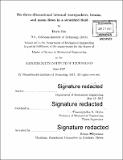| dc.contributor.advisor | Triantaphyllos R. Akylas. | en_US |
| dc.contributor.author | Fan, Boyu, Ph.D. Massachusetts Institute of Technology | en_US |
| dc.contributor.other | Massachusetts Institute of Technology. Department of Mechanical Engineering. | en_US |
| dc.date.accessioned | 2017-10-04T15:07:23Z | |
| dc.date.available | 2017-10-04T15:07:23Z | |
| dc.date.copyright | 2017 | en_US |
| dc.date.issued | 2017 | en_US |
| dc.identifier.uri | http://hdl.handle.net/1721.1/111763 | |
| dc.description | Thesis: S.M., Massachusetts Institute of Technology, Department of Mechanical Engineering, 2017. | en_US |
| dc.description | Cataloged from PDF version of thesis. | en_US |
| dc.description | Includes bibliographical references (pages 65-68). | en_US |
| dc.description.abstract | The long-time evolution and eventual dissipation mechanisms of internal waves in a stratified fluid are of fundamental geophysical importance. While much progress in recent years has been made on two-dimensional nonlinear internal wave evolution, the effects of three-dimensional variations are still poorly understood. In this thesis, we propose asymptotic models for the weakly nonlinear three-dimensional evolution of three types of internal wave disturbances: beam-like wavepackets, equally modulated wavepackets, and thin beams. Our models assess the combined effects of nonlinearity, three-dimensional modulations, viscosity, and background rotation to determine the roles that they play in wave evolution and instability. Our results indicate that internal waves with three-dimensional variations behave in very different ways than their two-dimensional counterparts. Most notably, in all three types of waves we consider, three-dimensional variations are necessary in triggering the nonlinear transfer of energy from waves to a large-scale time-mean flow via the action of Reynolds stresses. Furthermore, we show that two distinct mechanisms of mean flow generation exist, and each may result in wave breakdown. The first is an inviscid purely modulation-induced mean flow which can trigger the so-called modulational instability. The second is a combined viscosity and modulation-driven mean flow that establishes a resonant wave-mean flow interaction known as streaming. The relative importance of these two mean flow mechanisms and associated instabilities thus depends on the specific nature of the modulations and the importance of viscous dissipation. For instance, we show that beam-like waves, where modulations are weaker in the direction along constant phase lines, exhibit the coexistence of both types of mean flow. The robust nature of the induced mean flow indicates that three-dimensional variations may be of utmost importance in determining the fate of internal waves, both in the field and in the laboratory. | en_US |
| dc.description.statementofresponsibility | by Boyu Fan. | en_US |
| dc.format.extent | 68 pages | en_US |
| dc.language.iso | eng | en_US |
| dc.publisher | Massachusetts Institute of Technology | en_US |
| dc.rights | MIT theses are protected by copyright. They may be viewed, downloaded, or printed from this source but further reproduction or distribution in any format is prohibited without written permission. | en_US |
| dc.rights.uri | http://dspace.mit.edu/handle/1721.1/7582 | en_US |
| dc.subject | Mechanical Engineering. | en_US |
| dc.title | On three-dimensional internal wavepackets, beams, and mean flows in a stratified fluid | en_US |
| dc.title.alternative | On 3-dimensional internal wavepackets, beams, and mean flows in a stratified fluid | en_US |
| dc.title.alternative | On 3D internal wavepackets, beams, and mean flows in a stratified fluid | en_US |
| dc.type | Thesis | en_US |
| dc.description.degree | S.M. | en_US |
| dc.contributor.department | Massachusetts Institute of Technology. Department of Mechanical Engineering | en_US |
| dc.identifier.oclc | 1004857373 | en_US |
